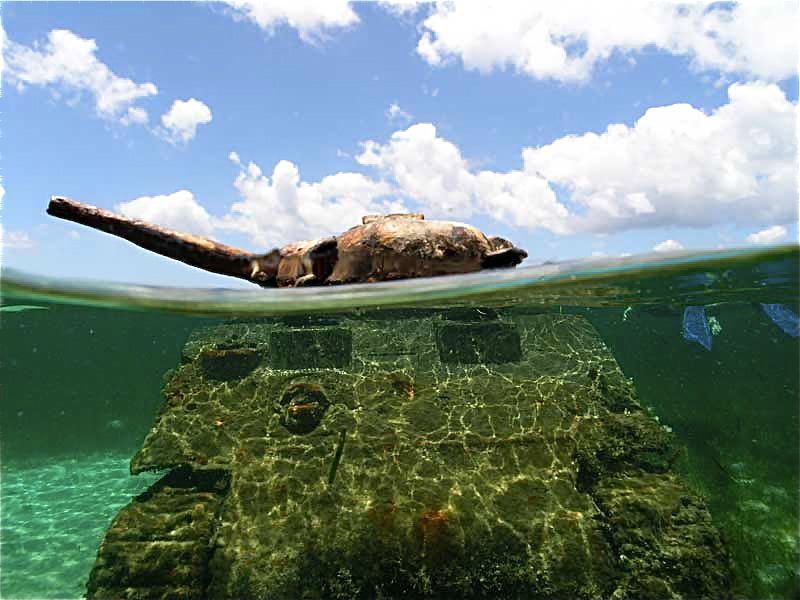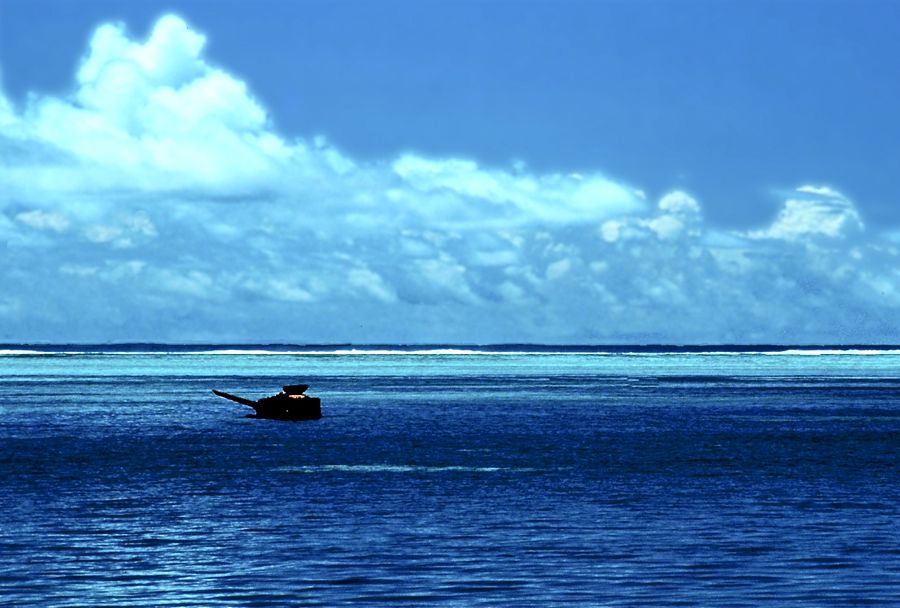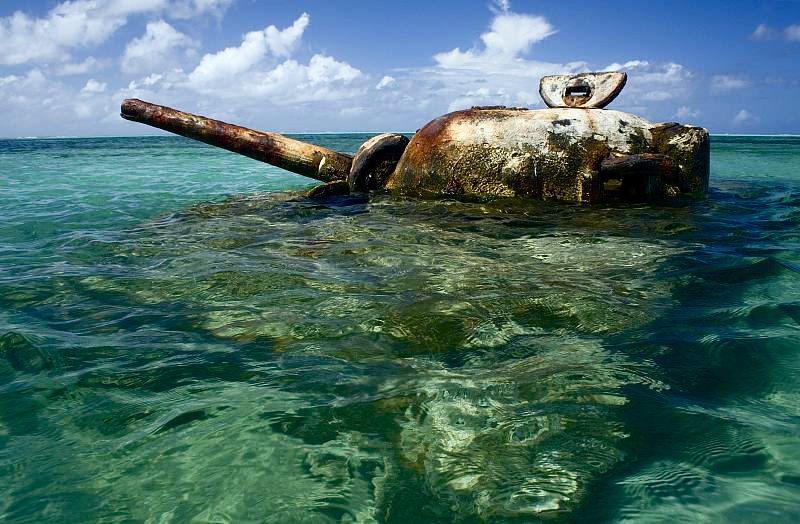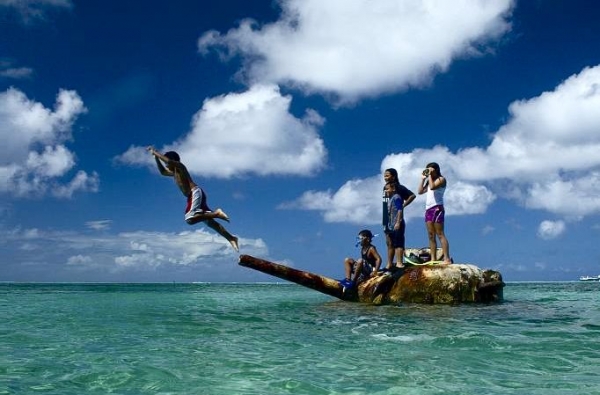The Battle of Saipan was a battle of the Pacific campaign of World War II, fought on the island of Saipan in the Mariana Islands from 15 June 1944 to 9 July 1944.
The invasion fleet embarking the expeditionary forces left Pearl Harbor on June 5, 1944, the same day Operation Overlord was launched with the invasion of Normandy. The Normandy landings were the larger amphibious landing, but the Marianas invasion fielded the larger fleet.
 By July 7, the Japanese had nowhere to retreat. Saito made plans for a final suicidal banzai charge. On the fate of the remaining civilians on the island, Saito said, “There is no longer any distinction between civilians and troops. It would be better for them to join in the attack with bamboo spears than be captured.” At dawn, with a group of a dozen men carrying a great red flag in the lead, the remaining able-bodied troops — about 3,000 men — charged forward in the final attack. Amazingly, behind them came the wounded, with bandaged heads, crutches, and barely armed. The Japanese surged over the American front lines, engaging both Army and Marine units. The 1st and 2nd Battalions of the 105th U.S. Infantry were almost destroyed, losing 650 killed and wounded. However, the fierce resistance of these two battalions, as well as that of Headquarters Company, 105th Infantry, and elements of 3rd Battalion, 10th Marines (an artillery unit) resulted in over 4,300 Japanese killed. For their actions during the 15-hour Japanese attack, three men of the 105th Infantry were awarded the Medal of Honor – all posthumously. Numerous others fought the Japanese until they were overwhelmed by the largest Japanese Banzai attack in the Pacific War.
By July 7, the Japanese had nowhere to retreat. Saito made plans for a final suicidal banzai charge. On the fate of the remaining civilians on the island, Saito said, “There is no longer any distinction between civilians and troops. It would be better for them to join in the attack with bamboo spears than be captured.” At dawn, with a group of a dozen men carrying a great red flag in the lead, the remaining able-bodied troops — about 3,000 men — charged forward in the final attack. Amazingly, behind them came the wounded, with bandaged heads, crutches, and barely armed. The Japanese surged over the American front lines, engaging both Army and Marine units. The 1st and 2nd Battalions of the 105th U.S. Infantry were almost destroyed, losing 650 killed and wounded. However, the fierce resistance of these two battalions, as well as that of Headquarters Company, 105th Infantry, and elements of 3rd Battalion, 10th Marines (an artillery unit) resulted in over 4,300 Japanese killed. For their actions during the 15-hour Japanese attack, three men of the 105th Infantry were awarded the Medal of Honor – all posthumously. Numerous others fought the Japanese until they were overwhelmed by the largest Japanese Banzai attack in the Pacific War.
I have never heard a first hand account of how this WW II Sherman tank ended up in the lagoon, a couple of hundred yards off the shore, so here is a composite of what seems most likely: Apparently the tides had mis-judged. I don’t have tide table for the invasion days on Saipan but it could well have been that the tidal condition was noted when there was a low tide but by the time the invasion took place the tide was high. The Tank was probably off-loaded from an Landing Ship, Tank or LST (not so jokingly referred to as Large Slow Targets) . It is also possible that the LST was disabled by Japanese shelling. The tank crew may have tried to make a mad dash to the beach but it was just too far away. The water was shallow enough that the crew probably escaped without drowning, but, the withering rain of bullets, artillery and mortar fire may have killed them.
Many hundreds of Japanese civilians committed suicide in the last days of the battle, some jumping from “Suicide Cliff” and “Banzai Cliff”. Efforts by U.S. troops to persuade them to surrender instead were mostly futile. Widespread propaganda in Japan portraying Americans and British as “devils” who would treat POWs barbarically, deterred surrender (see Japanese Military Propaganda (WWII)).
In the end, about 22,000 Japanese civilians died. Almost the entire garrison of troops on the island — at least 30,000 — died. For the Americans, the victory was the most costly to date in the Pacific War. 2,949 Americans were killed and 10,364 wounded, out of 71,000 who landed.
 This guy was about 300 meters off the beach. There were 3 but not really close to each other and this one is turned and looks to be engaged with a pillbox on the shore and has a nasty antitank round below the water line on the starboard side right behind the driver/front gunner. Being the typical tourists we couldn’t resist swimming out and getting close to it and checking it out. I will see if I can find the interior shots of it. What was really neat is the barrell is actually pointing at a bunker/pillbox that had taken a shot and collapsed.
This guy was about 300 meters off the beach. There were 3 but not really close to each other and this one is turned and looks to be engaged with a pillbox on the shore and has a nasty antitank round below the water line on the starboard side right behind the driver/front gunner. Being the typical tourists we couldn’t resist swimming out and getting close to it and checking it out. I will see if I can find the interior shots of it. What was really neat is the barrell is actually pointing at a bunker/pillbox that had taken a shot and collapsed.
I went to Saipan for a 3-day holiday myself about 5 years ago. I took photos of all the ruins but back then I knew nothing about photography so the shots would have sucked, and besides I’ve lost them all now anyway. I saw this tank, as well as the caves and last remaining guns of the Japanese hold-outs. I also took a trip up to the suicide cliffs, from which civilians jumped to their deaths, fearing the foreign ‘devils’ and believing death was better than surrender. That was quite depressing. The island was well scoured for bodies, but apparently people still find skeletons lurking in the undergrowth.

A student of mine from 5 years ago had a collection of spent ammo rounds from Saipan, that he’d gathered from a trip some 30 years ago, claiming shells had been lying all over the place. I suppose spent ammo would’ve been easier to pass through customs back then. I didn’t see any lying around when I went though.
